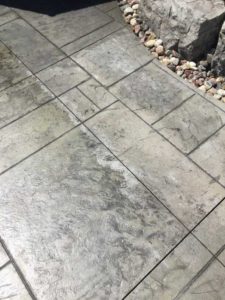
When guests arrive at a hotel, their first impression often begins at the entrance. In fact, approximately 80% of hotels feature a covered entrance, known as a porte-cochère, which not only offers shelter but also sets the stage for a guest's experience. For hotels looking to make a lasting impression, maintaining the pristine condition of their decorative and stamped concrete is crucial. Nox-Crete's Tri-Shield - A solvent-based acrylic polymer and silane type membrane cure, water-repellent and sealer is specifically designed to protect these surfaces from harsh environmental elements while enhancing their natural beauty with a glossy, wet-look finish.
Tri-Shield provides an exceptional defense against winter salt damage, a common concern for hotel owners and property management companies. Winter salt can wreak havoc on concrete surfaces, leading to unsightly damage and costly repairs. Tri-Shield features a silane additive that penetrates deeply into the concrete, creating a protective barrier that repels salt, water, and other harmful substances. This prevents water from penetrating the concrete during the winter months that causes freeze/thaw damage. This advanced protection not only preserves the integrity of the concrete but also extends its lifespan, making it a smart investment for any hotel or property management company looking to reduce maintenance costs while maintaining a high standard of appearance.
 Beyond its protective capabilities, Tri-Shield significantly enhances the aesthetic appeal of decorative and stamped concrete. The gloss wet-look finish it imparts highlights the intricate designs and textures, bringing out the full beauty and shine of the surface. This enhancement ensures that the hotel entrance remains vibrant and inviting, creating a memorable experience for guests. The glossy finish with a second coat not only adds visual appeal but also conveys a sense of cleanliness and luxury, aligning perfectly with the hospitality industry's standards.
Beyond its protective capabilities, Tri-Shield significantly enhances the aesthetic appeal of decorative and stamped concrete. The gloss wet-look finish it imparts highlights the intricate designs and textures, bringing out the full beauty and shine of the surface. This enhancement ensures that the hotel entrance remains vibrant and inviting, creating a memorable experience for guests. The glossy finish with a second coat not only adds visual appeal but also conveys a sense of cleanliness and luxury, aligning perfectly with the hospitality industry's standards.
To further enhance safety and functionality, Nox-Crete recommends using their Non-Slip Additive for porte-cochères and covered entrance canopies. This additive consists of finely ground bleached aluminum oxide, which is broadcast and back-rolled into the last coat of sealer. This process improves slip resistance, making it a crucial addition for areas exposed to foot and vehicle traffic. Ideal for pool decks, walkways, steps, patios, and garage floors, the Non-Slip Additive is designed for exterior concrete surfaces and is compatible with both water and solvent-based sealers. By incorporating this additive, hotel entrances can maintain their aesthetic appeal while ensuring the safety of guests and staff.
Hotels and property management companies are consistently looking for ways to improve the durability and appearance of their properties while enhancing safety. By offering these Nox-Crete solutions as an add-on service, contractors can provide significant value to their clients. The benefits of reduced maintenance costs, enhanced visual appeal, and improved safety are compelling selling points, making these products attractive propositions for property managers seeking to elevate their facilities' curb appeal.
Partnering with Nox-Crete and utilizing Tri-Shield and the Non-Slip Additive not only enhances the quality of concrete surfaces but also positions contractors as experts in their field, capable of offering cutting-edge solutions to common problems. These products are easy to apply and provide long-lasting results, ensuring that contractors can deliver outstanding service with minimal effort. By incorporating Tri-Shield and the Non-Slip Additive into their offerings, construction professionals can strengthen their relationships with hotel owners and property managers, ultimately driving business growth and success.
In conclusion, Nox-Crete's Tri-Shield - Silane Cure and Sealer, along with the Non-Slip Additive, are vital tools for protecting, enhancing, and ensuring the safety of decorative and stamped concrete in hotel entrances. Their superior protection against winter salt damage, ability to create a striking gloss wet-look finish, and improved slip resistance ensure that hotel porte-cochères and canopy entrances areas remain beautiful, durable, and safe. For construction distributors and contractors, these products offer an easy upsell opportunity that adds value to their services and meets the needs of discerning clients in the hospitality industry.
 chemical solutions to concrete problems
chemical solutions to concrete problems






